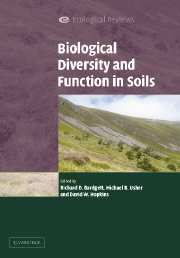Book contents
- Frontmatter
- Contents
- List of contributors
- Preface
- Acknowledgements
- PART I Introduction
- PART II The soil environment
- 2 The habitat of soil microbes
- 3 Twenty years of molecular analysis of bacterial communities in soils and what have we learned about function?
- 4 Carbon as a substrate for soil organisms
- PART III Patterns and drivers of soil biodiversity
- PART IV Consequences of soil biodiversity
- PART V Applications of soil biodiversity
- PART VI Conclusion
- Index
- References
4 - Carbon as a substrate for soil organisms
Published online by Cambridge University Press: 17 September 2009
- Frontmatter
- Contents
- List of contributors
- Preface
- Acknowledgements
- PART I Introduction
- PART II The soil environment
- 2 The habitat of soil microbes
- 3 Twenty years of molecular analysis of bacterial communities in soils and what have we learned about function?
- 4 Carbon as a substrate for soil organisms
- PART III Patterns and drivers of soil biodiversity
- PART IV Consequences of soil biodiversity
- PART V Applications of soil biodiversity
- PART VI Conclusion
- Index
- References
Summary
SUMMARY
In many ecological studies, soil carbon is regarded as a barely differentiated whole with little attention paid to its underlying characteristics.
Although it is widely appreciated that decomposer organisms are nearly infallible as degraders of organic molecules, there are marked differences in the utilisation of different components of organic matter by organisms depending on chemical and physical characteristics, location and availability in time in soil.
We discuss the characteristics of soil carbon as a substrate and emphasise a ‘soil metabolomic’ approach for characterising the range of molecules in complex, composite substrates, and the potential that stable isotope probing offers for linking organisms to their substrates via enrichment of their biomolecules as they exploit isotopically enriched substrates.
Using selected examples, we examine the influence of the chemical characteristics/quality, quantity, location and timing of supply of organic matter on the amount, activity and, where possible, the diversity of soil organisms.
We are some way from unifying relationships between the quality, quantity, location and timing of delivery or availability of soil carbon on the size, activity and diversity of soil organisms. However, we point ways forward in which the information on the physics, chemistry and management are linked to the biology of soils.
Introduction
Currency of soil carbon
Humans view soil carbon in various physical (e.g. aggregates, density fractions), chemical (e.g. carbohydrates, aromatic compounds), biological (e.g. microbial biomass) and even economic (e.g. dollars per tonne or carbon credits) ways which are not usually ecological.
- Type
- Chapter
- Information
- Biological Diversity and Function in Soils , pp. 57 - 80Publisher: Cambridge University PressPrint publication year: 2005
References
- 8
- Cited by



